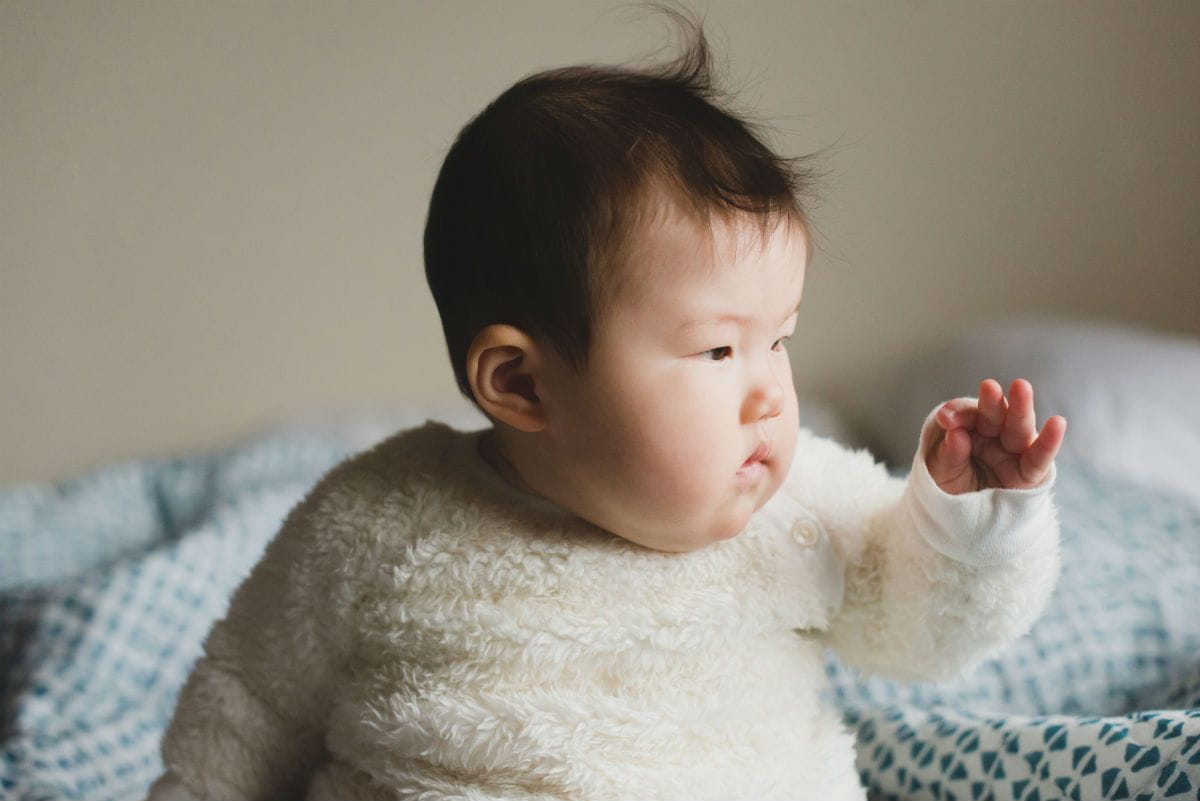If Baby Feeds Self With Left Hand is She Left Handed

By Carolyn Sweeney Hauck
Are you wondering if your baby will be left-handed?
You may have to wait a couple of years to know. Starting out, babies will use both hands to reach for mobiles, your sparkly necklace, or to pull your face in close. That's because reaching, grabbing, (and of course, putting their oh-so-adorable hands in their mouths for some good ol' slobbery sucking) are simple tasks that don't require control over specific, smaller muscles. Hand dominance only evolves as baby's fine-motor skills develop. Until those skills develop, both hands get equal play.
As children grow, however, so does their ability to perform increasingly complex tasks (like scribbling or eating with a spoon). It's at this point, usually around age two or three, that you may notice your tot using one hand more than the other.
However, some children will exhibit signs of left-handedness around the 18-month mark. Does she reach for food or toys with her left hand all the time? When she paints, does she hold that brush in a cute little left-handed fist? These signs may indicate you've got a lefty, but not necessarily: Generally speaking, you'll have to wait for her to fully establish her handedness (around age five or six) to see whether you've got a true "southpaw."
Does left-handedness or right-handedness really matter in life? Some people certainly think so. After all, only 10 to 12 percent of people are left-handed, a statistic that automatically connotes a certain "specialness" to the lefties of the world. Science journalist/proud lefty David Wolman even wrote an entire book about being left-handed. (The right-handed people among us have no such tome.)
Everyone Belongs In Our Circle
At KinderCare, we're committed to building warm, welcoming and supportive classrooms for children of all abilities, backgrounds and experiences.
Find a center near you
Special or not, lefties are born, not made: Genetics are at least partially responsible for handedness. Up until last year, it was assumed that hand preference comes from asymmetrical genes in the brain—two hands, two brain hemispheres, one is dominant. Well, here's the problem with that theory: Babies in the womb already show preference by moving one arm more than the other, before the part of the brain responsible for those movements is functional. Turns out that by the eighth week of pregnancy, genes in the baby's spinal cord already show the beginning of right-left preference—before the connection between the spinal cord and brain is fully formed. In other words, evidence shows that the brain isn't where hand preference starts. The spinal cord is!
This new finding may well put to bed our obsession with linking handedness to left and right brain hemispheres. That's a lefty myth worth busting: Many people believe that lefties are more artistic, because (so goes the thinking) they use the right hemisphere of the brain more, which is responsible for spatial and visual understanding. As it turns out, though, none of us have a right- or left-brain preference—we all use both sides of our brain equally. So no, your left-handed child isn't genetically set up to become the next Mozart or Matisse.
The only area of lefty advantage that might have some muscle behind it is sports, as it has been shown that there is a pronounced presence of lefties in interactive sports like tennis and baseball. Why? It could be that right-handed players have a harder time blocking them, or that certain movements are easier to perform left-handed—but the jury is still out on whether there's an actual advantage there.
All of this is to say is that if you end up having a left-handed child, you have…well, a left-handed child. He'll be no different than his right-handed friends—well, of course, he'll be different, his own version of himself with an infinite number of future possibilities in front of him. Teacher, dancer, computer programmer, pilot, salesperson—his options are unlimited, no matter what hand he uses.
Still, there are some, ahem, handy parenting tips to make sure your left-handed child becomes the confident learner she's meant to be. Take a look!

1. Invest in a Good Pair of Left-Handed Scissors
Right-handed scissors have the sharper part of the blade on the left side, so if a child tries to use them with his left hand (which he will), the dull part of the blade won't cut the piece of paper or string. (ARGH!) Your child might feel like he doesn't know how to cut it himself, and no kid likes that feeling. It's not his fault—the scissors weren't made for him! Keep him confidently crafting with his own pair of lefty scissors.
Pro tip: It's easier to find lefty scissors online.
2. When You Can, Use Your Left Hand
While you can probably get away with using your right hand to teach her how to, say, eat with a fork, it's going to get more complicated if you want to teach your left-handed child how to tie her shoe, use chopsticks, or write her name.
As a righty, modeling these tasks with your left hand can be a brain puzzler, but you actually have the advantage here! As a right-handed person trying to do something with your left hand, you'll likely need to slow down and think through the steps a little more carefully—plus, kids usually need grown-ups to slow down when they're teaching something. That said, it's probably a good idea to practice on your own a few times before you show him how to make "the bunny ear"!
A Lifetime Of Confidence Starts Here
Our teachers help every child build the confidence they need to try new things and explore the world around them.
Search for a center near you
3. Celebrate Your Lefty
It is true that lefties are uncommon, and it's also true that it's a right-handed world out there. Many a kitchen pot and coffee mug are made with handles for right-handed orientation (a subtle distinction you righties might not ever have noticed). Right hands are presented for hand shakes, not left hands. Plus, there's the whole elbow thing at a crowded table: A lefty will probably be sitting next to a right-handed person, which means they'll be knocking elbows as they try to eat. Alas!
Luckily, to make up for these injustices, there are gifts—like the notebooks with the wire spiral on the right side so lefties don't have to rub their hands in pen ink. (Genius!) When you're raising a left-handed child, it's nice to buy her a few fun gift items for her birthday (in addition to her scissors) so she feels like the special girl she is.
Source: https://www.kindercare.com/content-hub/articles/2018/february/left-handed
Belum ada Komentar untuk "If Baby Feeds Self With Left Hand is She Left Handed"
Posting Komentar